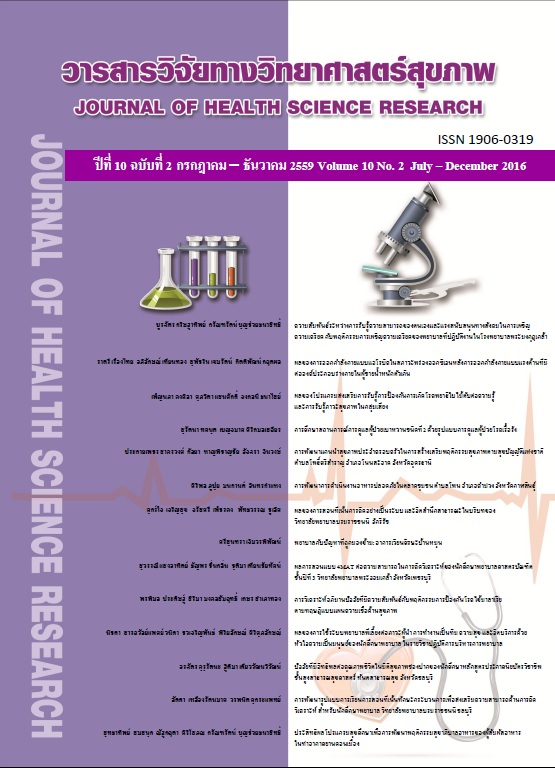การพัฒนาการดำเนินงานอาหารปลอดภัยในตลาดชุมชน ตำบลโพน อำเภอคำม่วง จังหวัดกาฬสินธุ์
Main Article Content
บทคัดย่อ
การวิจัยครั้งนี้เป็นการวิจัยเชิงปฏิบัติการ (Action research) มีวัตถุประสงค์เพื่อศึกษากระบวนการพัฒนาการดำเนินงานอาหารปลอดภัยในตลาดชุมชนของตำบลโพน อำเภอคำม่วง จังหวัดกาฬสินธุ์ กลุ่มตัวอย่างที่ใช้ในการวิจัยครั้งนี้ ได้จากการคัดเลือกแบบเจาะจง (Purposive sampling) จำนวน 60 คน เพื่อเข้าร่วมกิจกรรมในการประชุมเชิงปฏิบัติการ โดยใช้กระบวนการ Appreciation Influence Control (AIC) ประกอบไปด้วย เจ้าหน้าที่กองสาธารณสุขและสิ่งแวดล้อม (3 คน) ตัวแทนผู้ขายสินค้าในตลาด (10 คน) ตัวแทนผู้นำชุมชน (5 คน) ตัวแทน อสม. (17 คน) และตัวแทนกลุ่มแม่บ้าน (25 คน) ดำเนินงานตามกระบวนการวิจัยเชิงปฏิบัติการ เก็บข้อมูลทั้งเชิงปริมาณและเชิงคุณภาพ ทำการวิเคราะห์และสังเคราะห์เป็นรูปแบบการดำเนินงานที่ได้จากการศึกษาครั้งนี้
ผลการวิจัยพบว่า การพัฒนาการดำเนินงานอาหารปลอดภัยในตลาดชุมชนในครั้งนี้มี 6 ขั้นตอนคือ 1) ศึกษาวิเคราะห์บริบทและสภาพปัญหา 2) ประชุมเชิงปฏิบัติการวางแผนแบบมีส่วนร่วม 3) จัดทำแผนปฏิบัติการ 4) ปฏิบัติตามแผนงาน/โครงการ 5) ติดตาม สนับสนุนและประเมินผล 6) จัดเวทีแลกเปลี่ยนเรียนรู้และถอดบทเรียน และได้แนวทางปฏิบัติที่ดีคือ การกระตุ้นให้ชุมชนเกิดการรับรู้สภาพปัญหา (Stimulation) การวิเคราะห์ปัญหา (Analysis) เพื่อกำหนดแผนการดำเนินการของตลาดชุมชนร่วมกัน โดยการมีส่วนร่วม (Participation) ทุกขั้นตอนการดำเนินงาน การทำงานเป็นทีม (Team work) และการจัดการความรู้ (Knowledge management) ในองค์กร
ปัจจัยความสำเร็จในการดำเนินงานครั้งนี้คือ ความยินดีและสมัครใจร่วมโครงการ เครือข่ายชัดเจนเข้มแข็ง การทำงานเป็นลักษณะภาคีเครือข่าย การสร้างแรงจูงใจเชิงบวก เข้าร่วมกิจกรรมในทุกระดับ มีความต่อเนื่องของโครงการ การติดตามและรายงานผลอย่างสม่ำเสมอ
This action research was conducted to study the development, implementation, food insecurity in the parish community Phon, Kham Muang District, Kalasin Province. The Appreciation Influence Control process was used. Samples of 60 people were purposively selected to join the research workshop. Samples were consisted of 3 officials of public health and environment, 10 sellers representatives, 5 community leaders, 17 village health volunteers and 25 housewife representatives. Quantitative and qualitative research methods were applied in this study.
The results showed that development of food safety in the community requires six steps: 1) analyzing the context and the problems; 2) participatory workshops; 3) creating action plan; 4) following the plan; 5) evaluating and following up; and 6) organizing seminars and lessons learned. The good practice is stimulating community awareness regarding problems and analysing problems to set up the action plan of the community together, engaging community in all stages of operation, team working, and Knowledge Management in the organization.
In summary, the key success factors in this operation is willingness and voluntary participation, strong network, positive incentives, continuation of the project report.
Downloads
Article Details
บทความที่ได้รับการตีพิมพ์เป็นลิขสิทธิ์ของวิทยาลัยพยาบาลบรมราชชนนี จังหวัดนนทบุรี
ข้อความที่ปรากฏในบทความแต่ละเรื่องในวารสารวิชาการเล่มนี้เป็นความคิดเห็นส่วนตัวของผู้เขียนแต่ละท่านไม่เกี่ยวข้องกับวิทยาลัยพยาบาลบรมราชชนนี จังหวัดนนทบุรี และคณาจารย์ท่านอื่น ในวิทยาลัยฯ แต่อย่างใด ความรับผิดชอบองค์ประกอบทั้งหมดของบทความแต่ละเรื่องเป็นของผู้เขียนแต่ละท่าน หากมีความผิดพลาดใด ๆ ผู้เขียนแต่ละท่านจะรับผิดชอบบทความของตนเองแต่ผู้เดียว


